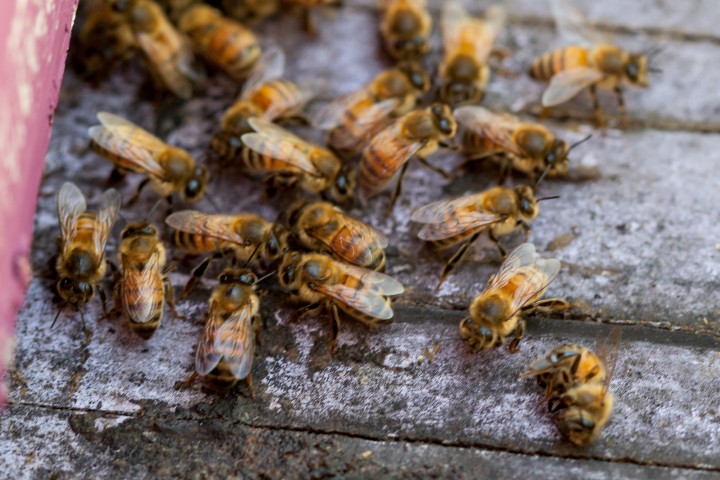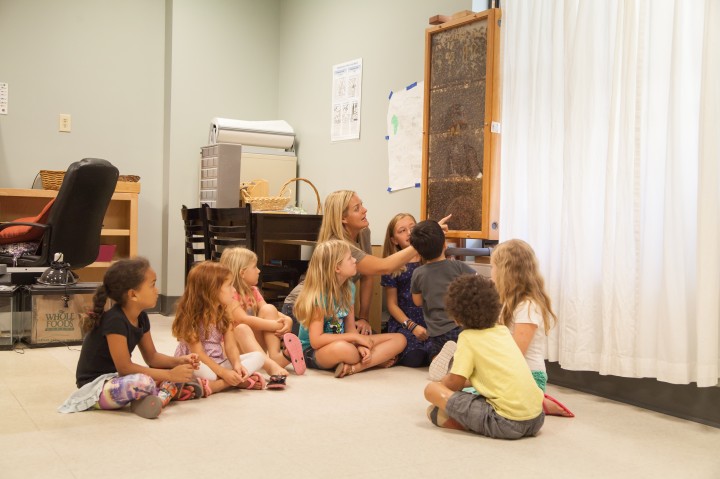
Think about the last meal you prepared and how tasty it was. Thanks to the “locavore” movement sweeping the nation, you might feel gratitude to local farmers for such a spread – but what about the humble honey bee? Despite their misunderstood reputation, honey bees are a critical part of the food cycle, and they’re not going to sting you out of pure malice, either. In fact, according to the beekeepers and bee lovers I’ve met, it’s time we stop fearing these fuzzy beings and begin honoring and protecting their hard work for our own good.
Isle of Palms resident Tami Enright is the founder of the Bee Cause Project, a popular organization that helps get honey bee hives installed in area schools for educational purposes and also promotes justice and respect for our honey bee friends. The morning Enright and I met downtown at 1600 Meeting St., the hive installed in the conference room had narrowly missed “a swarm,” meaning that about half of the hive’s members tried to leave the hive and relocate elsewhere.
“I don’t know how the bees decide who stays and who goes,” Enright said, “but the departing bees will find a new home a few miles away, like a hole in a tree. A few go at first to find the new “real estate,” and then the entire group follows.”
Enright’s love for bees is obvious, from her words right down to the hive necklace hanging around her neck. Her fascination with them started when she took a gardening course through Clemson Extension, followed by a weekend beekeeping course at The Citadel. She now has two hives of her own in her front yard, not to mention more than 60 requests for honey bee hives throughout the Charleston County school system through the Bee Cause Project. The first school with a hive was Sullivan’s Island Elementary; now SIE is having its second hive installed. Other schools in East Cooper with hives include Whitesides Elementary and East Cooper Montessori.
“I write grants to get funding for Bee Cause, and we also have a lot of businesses who are willing to sponsor a hive,” Enright explained. “For example, Cinebarre donated money for the second hive at Sullivan’s Island Elementary; the owner’s daughter attends there.”
Perhaps you have heard the dismaying news that honey bees are currently in trouble. I brought this up to Enright, and she confirmed it.
“The bees are dying – 30 to 40 percent this year,” she said. “The reasons bees are dying include no diversity in their diets. Think how humans can’t live on carrots alone; bees are the same way. Secondly, many plants are sprayed with chemicals. They’re also suffering loss of habitat.”
My face fell, but Enright was swift to keep me engaged and hopeful, pointing out that “the more you learn about bees, the more addictive it is – and it helps you understand the natural world.” She taught me that honey bees pollinate one out of three bites of our food. Without them, what we eat would be pretty bland. Who knew, right?
Sensing my natural love for bees (I’ve always had a soft spot for them, and I’ve never been afraid of them), Enright suggested that I might want to adopt a hive of my own. I sheepishly reported that I live in a condo, so it probably wouldn’t work. Then I learned about the Charleston Community Bee Gardens.
Currently led by president Jim Strohm, Charleston Community Bee Gardens is an organization that installs public gardens to create a safe haven for bees and bee lovers alike. There are currently four hive locations in the area: Awendaw, Johns Island, Wadmalaw Island and West Ashley. The mission, according to Strohm, is to provide a place for beekeepers who don’t have their own hives. As you can imagine, I soon made plans to visit the bee garden at the Sewee Visitor & Environment Education Center in Awendaw.
“It’s like a community gathering place for bees,” Strohm pointed out. “We put the hives near flowers so the bees have food.”
Charleston Community Bee Gardens, a nonprofit that is open for everyone to join, has been around for about three-and-a-half years. In fact, if you’re interested after reading this article, you can sign up for beekeeping courses at the Sewee Visitor & Environment Education Center. Completion of the two-day course grants membership in the organization, plus certification and membership in the South Carolina Beekeepers Association. It’s also a fantastic way to cover important bee topics, according to Strohm, who mentioned that mentoring new beekeepers is one of his favorite aspects of leading the organization.
“Beekeeping is not a science; it’s an art,” he commented. “There are different theories on how to do things, and all beekeepers do things differently.”
Strohm and Enright are both enthusiastic about teaching Lowcountry children – the next generation of beekeepers and bee lovers – how to understand and protect these fascinating critters. The Bee Cause project has just been approved for the entire Charleston County School District – depending on the approval of individual principals – and Enright is looking forward to educating even more youngsters about honey bees. Meanwhile, Strohm’s long-term goal for the Charleston Community Bee Gardens is to offer summer camps in Awendaw for junior beekeepers.
“Kids do basketball and soccer camp, so why not beekeeping camp?” he asked.
“It’s all about educating others about bees and what we can do for them,” added Enright. “Since I’ve been doing it, I’ve learned something new every day.”
By Denise K. James
Photos by Cassandra Michelle Photography.

What can I do to help the bees?
Create a small habitat – such as compost, bushes or bramble – to provide a home for honey bees.
Keep a water source in your yard for the bees during warmer months. Hives have to be kept at a certain temperature and water helps cool them down.
“Bee” conscientious about chemicals and pesticides you use in your yard and garden.
Educate yourself and your family regarding year-round blooms and plants that can survive slightly cooler temperatures, and consider planting a few in your yard to feed the bees during the winter months.
Eat locally, and get to know your farmers.
Join a bee-friendly organization and donate to the cause.

Leave a Reply